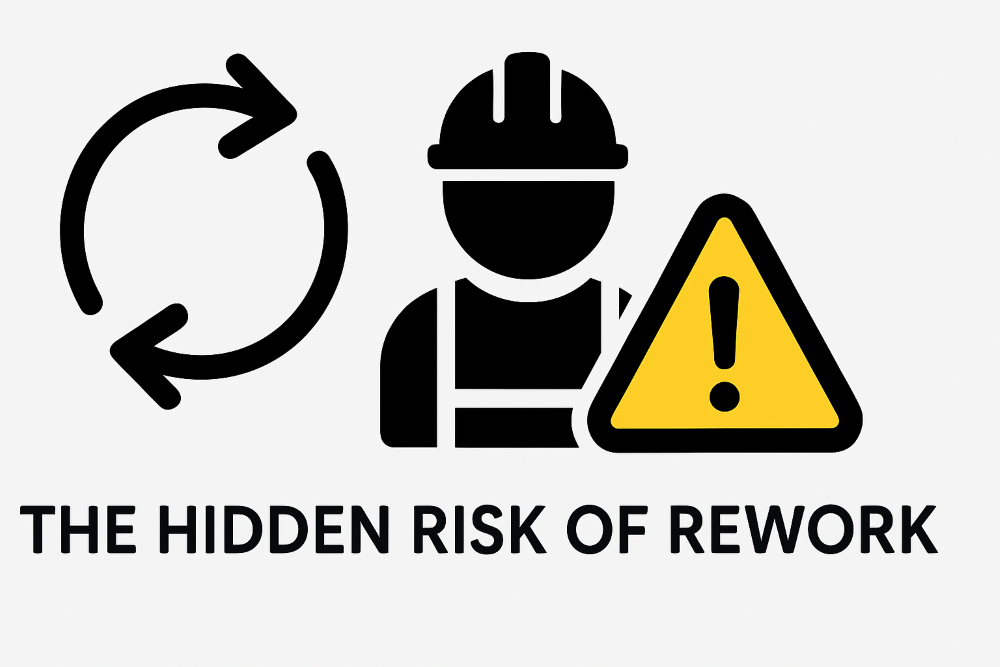I recently posted on LinkedIn about my experience with a broadband installation that went wrong outside my house. And one point struck a chord— the increased risk associated with rework.
In my very early days as a development chemist, I mostly saw rework as a frustration — a pain that got in the way of progress. When I was a manufacturing manager, I often thought of rework in terms of lost time, cost overruns, or project delays. But what I didn’t fully appreciate back then, and what many people still overlook, is just how serious the health and safety consequences of rework can be.
A personal lesson
Back at the start of my working life, as a young development chemist, I made a mistake in an experiment that meant it had to be repeated — pushing my day later than planned. Towards the end of the day, I was rushing back to the lab to clean some highly specialised glass plates.
It was a task I’d done a thousand times without issue.
But because I was behind schedule, I cut a corner. I didn’t put on my safety glasses when I went back into the lab.
While cleaning up, the distillation vessel I was using bumped - giving a sudden, uncontrolled release of vapour. In an instant, boiling alcohol sprayed across my face.
Thankfully, I wasn’t seriously injured. But it was a frightening experience for someone new to work in the early part of their career. It wasn’t a dangerous task in itself. It went wrong because I was rushing, under pressure, and outside my normal routine. And crucially, I was only in that position because I’d had to rework the experiment earlier in the day.
It’s a mistake I only made once. And it left me with a lasting lesson: rework doesn’t just cost time and money - it creates risk.
Why rework increases risk
Rework often involves returning to tasks that have already been completed, usually under pressure, outside of the normal workflow, and at times when attention is lower. You’re pushing to “just get it done”.
This creates a perfect storm for accidents:
- Out-of-sequence work could differ to your safe systems of work and introduce unfamiliar hazards.
- Compressed timelines lead to shortcuts or overlooked checks.
- Fatigue and frustration increase the likelihood of human error.
- Extra exposure time raises the chance of incidents around machinery, vehicles, or hazardous materials.
A 2020 industry study found that rework can increase the likelihood of an incident or injury by up to 70% compared to work done right first time. That statistic alone should give anyone serious about safety pause for thought.
Rework is a leading indicator of deeper issues
Rework isn’t just a productivity issue; it’s often a red flag that something isn’t right. It can indicate:
- Inadequate planning or flawed design
- Miscommunication between teams
- Gaps in training or supervision
- Poorly maintained or inappropriate equipment
Left unaddressed, these problems don’t go away. They just lead to more rework and more risk down the line.
The real cost of rework
The visible costs of rework are well documented. According to the Construction Industry Institute (CII), rework can account for 5–20% of total project costs across sectors.
But the hidden costs are just as important:
- Missed deadlines and falling morale
- Erosion of trust from clients or the public
- Increased scrutiny from regulators
- Sustainability impact of additional materials and machine/vehicle operation
- And, in the worst cases, serious injury or loss of life
The safety case for doing it right first time
Creating a “right first time” culture isn’t just about quality. It’s a powerful safety tool. When teams are set up to succeed with the right equipment, time, training, and support people are safer, not just more efficient.
Fewer interventions mean fewer opportunities for harm. Consistent, well-executed tasks create stable, predictable work environments. And morale improves when workers know they’re set up to succeed.
Conclusion: prevention is protection
It’s tempting to treat rework as just one of those things - an inevitable part of complex operations. But normalising it is risky. Every unnecessary repeat of a task brings another chance for someone to get hurt. And we know that repetition can cause complacency.
If we’re serious about safety, we need to be just as serious about quality. Because when we get it right first time, we’re not just saving time and money, we’re saving lives.


